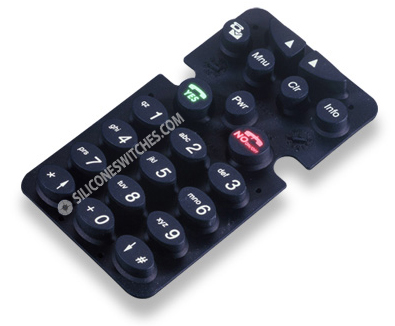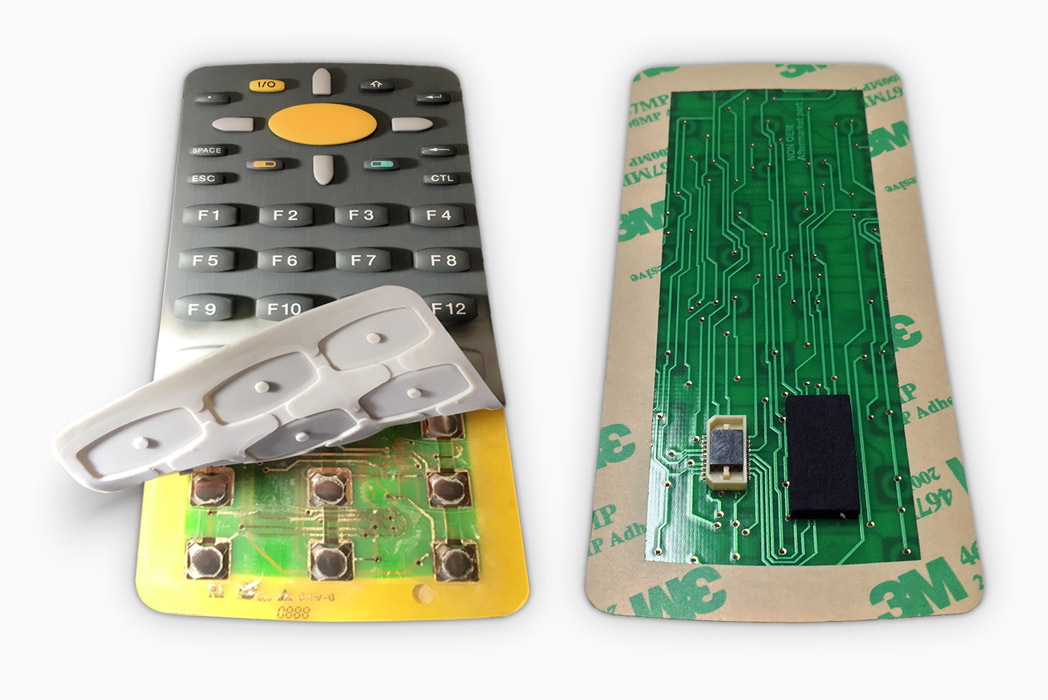Why illuminated Rubber Keypads are gaining popularity in smart devices
Uncovering the Diverse Enters and utilizes of Rubber Keypads in the Innovation Landscape Today
Rubber keypads have established themselves as necessary elements in different technical applications. Their adaptability makes them appropriate for customer electronics, industrial makers, and medical gadgets. As these keypads remain to develop, brand-new personalization choices and design fads emerge. This motivates a more detailed exam of their benefits and manufacturing processes. Understanding these components may disclose why rubber keypads continue to be a recommended option in the technology landscape. What exists in advance for this functional element?
Review of Rubber Keypads
Rubber keypads act as an essential component in different electronic gadgets, providing a tactile user interface for individual communication. These keypads are typically made from silicone or rubber materials, which offer flexibility and longevity. Their design typically incorporates elevated letters or symbols, enhancing use by allowing individuals to feel the secrets - Rubber Keypads. Rubber keypads are immune to dirt, wetness, and put on, making them appropriate for requiring environments
They can be personalized regarding dimension, form, and shade, permitting manufacturers to create unique user interfaces customized to details products. The production process typically includes strategies such as molding and printing, guaranteeing top notch output. Because of this, rubber keypads not only boost functionality yet likewise add to the general aesthetics of the gadget. With these characteristics, rubber keypads stay a popular selection for both makers and consumers, emphasizing their importance in the technology landscape.
Usual Applications in Consumer Electronic Devices
While numerous electronic gadgets count on touchscreens for individual communication, rubber keypads continue to play a necessary duty in consumer electronics. These keypads are widely used in gadgets such as remote controls, gaming controllers, and house appliances, where responsive comments improves individual experience. Their toughness and resistance to use make them perfect for devices frequently subjected to hefty use.
Rubber keypads are additionally preferred in cellphones and mobile gizmos, where compact styles necessitate trusted and responsive input techniques. The ability to personalize the shape and appearance of rubber keypads permits producers to create special designs that interest customers. In addition, the soft touch of rubber supplies convenience throughout extended use, making these keypads a favored choice for tools needing extensive interaction. On the whole, rubber keypads continue to be an important part in the consumer electronic devices landscape, integrating functionality with straightforward functions.
Duty in Industrial and Medical Tools
Rubber keypads play a vital duty in both commercial and clinical devices, using durability and dependability popular environments. In commercial settings, they are typically utilized in control panels and equipment, boosting driver communication with complicated systems. In a similar way, in the clinical area, rubber keypads assist in straightforward interfaces for devices that require precision and health.
Industrial Tools Applications
Keypads play an important role in the functionality and user experience of industrial and clinical devices. In commercial setups, rubber keypads supply a robust interface for machinery and control systems, permitting drivers to conveniently input commands and change setups. Their resistance to dirt, dampness, and chemicals warranties reliability under extreme conditions common of factories and manufacturing plants. Furthermore, the tactile responses offered by rubber keypads enhances individual interaction, lowering the likelihood of input errors. Along with conventional machinery, these keypads are essential in automated systems and robotics, where accuracy is extremely important. The convenience of rubber keypads in different commercial applications underscores their significance in improving functional effectiveness and guaranteeing safety in intricate settings.
Medical Tool Combination
As medical devices progressively need easy to use interfaces, the assimilation of rubber keypads has actually become essential in ensuring efficient communication between healthcare professionals and tools. These keypads supply tactile comments, helping with instinctive procedure also in high-pressure settings. Their longevity and resistance to rough cleaner make them perfect for clinical setups, where health and longevity are essential. Additionally, rubber keypads can be tailored to include different shapes, dimensions, and colors, boosting visual acknowledgment and availability for customers. This adaptability enables the production of specialized controls tailored to particular medical features, improving total performance. As a result, the duty of rubber keypads in clinical tool integration not just boosts functionality but likewise promotes individual safety and security and operational integrity in health care settings.
Personalization Options and Style Trends
Current style patterns stress minimalism and ergonomics, prioritizing user comfort and user-friendly interaction. Personalized logos and branding can be integrated into keypads, permitting companies to preserve a cohesive brand identification across their items. In addition, improvements in making strategies, such as silicone molding, have made it much easier to accomplish complex styles and customized formats.
Advantages of Rubber Keypads Over Other Types
Rubber keypads are likewise known for their sturdiness and resistance to environmental factors. They can endure dampness, temperature, and dust fluctuations, making them optimal for exterior or commercial setups. Additionally, rubber keypads are typically quieter than their plastic or steel counterparts, minimizing noise air pollution in common atmospheres.
Furthermore, the cost-effectiveness of rubber keypads makes them an appealing alternative for suppliers. Their lightweight nature adds to lower shipping expenses, while their personalized styles accommodate certain branding demands. Overall, rubber keypads stand for a flexible and dependable remedy in the technology landscape.
Manufacturing Techniques for Top Quality and Toughness
In the production of rubber keypads, the option of ideal materials and molding processes plays pop over here an important duty in establishing overall high quality and toughness. Various molding strategies, such as compression and shot molding, substantially affect the end product's efficiency. Comprehending these aspects is essential for achieving excellent results in rubber keypad production.
Molding Processes Discussed
A selection of molding procedures play an essential function in the production of rubber keypads, ensuring both top quality and toughness. The most typical techniques consist of compression molding, transfer molding, and injection molding. Compression molding entails placing rubber in a warmed mold, where warmth and pressure form it right into the preferred type. Transfer molding permits for even more specific control over product circulation and is appropriate for complicated designs (Rubber Keypads). Shot molding, recognized for its speed and effectiveness, infuses molten rubber right into a mold and mildew under high pressure, creating high-volume get rid of consistent quality. Each method provides distinct benefits, influencing variables such as manufacturing design, cost, and speed flexibility, eventually affecting the performance and lifespan of rubber keypads in numerous applications
Product Selection Value
Product selection plays a necessary role in the production of rubber keypads, directly affecting their efficiency and durability. The option of rubber substances, such as silicone or polyurethane, effects responsive comments, resistance to use, and ecological sturdiness. Premium products ensure that keypads can endure comprehensive usage, preserving their performance with time. Additionally, the formulation of rubber impacts its resistance to temperature level variations and exposure to chemicals, which are crucial for tools in various environments. Using advanced manufacturing strategies, such as compression or injection molding, more improves the architectural stability of keypads. Ultimately, cautious material choice and manufacturing processes contribute greatly to the total quality, longevity, and individual satisfaction of rubber keypads in today's innovation landscape.
Future Patterns in Rubber Keypad Modern Technology
As modern technology proceeds to advance, the future of rubber keypad development shows up encouraging, with innovations poised to boost functionality and customer experience. One noteworthy fad is the integration of touch-sensitive technology, enabling from this source capacitive feedback that imitates the feeling of typical buttons while supplying improved responsiveness. Furthermore, the advancement of antimicrobial materials is most likely to acquire grip, addressing hygiene worries in public and common gadgets.
Modification options are anticipated to increase, allowing customers to personalize vital formats and responsive comments, therefore providing to varied requirements. The incorporation of smart technology, such as connectivity features, might likewise emerge, allowing rubber keypads to communicate with various other gadgets flawlessly. As producers concentrate on sustainability, eco-friendly products are anticipated to become a lot more common, lining up with international environmental objectives. Generally, these patterns assure to reinvent rubber keypads, making them a lot more versatile, easy to use, and eco aware in the innovation landscape.
Frequently Asked Concerns
Just How Do Rubber Keypads Contrast in Price to Various Other Keypad Types?
Rubber keypads usually provide a cost-effective solution contrasted to other keypad types, such as membrane layer or mechanical options. Their reduced manufacturing expenditures and sturdiness make them an eye-catching option for numerous applications in technology.
What Are the Environmental Impacts of Rubber Keypad Manufacturing?


The ecological influences of rubber keypad manufacturing consist of resource depletion, power intake, and pollution from making processes. Additionally, inappropriate disposal can bring about plastic waste, adding to ecological degradation and damaging communities otherwise taken care of properly.
Can Rubber Keypads Be Made Use Of Outdoors?
Rubber keypads can be utilized outdoors because of their durability and resistance to weather elements. Their durability might depend on the high quality of products made use of and the particular ecological problems they are subjected to.
What Maintenance Is Needed for Rubber Keypads?
Rubber keypads need regular cleaning to eliminate dirt and debris, routine evaluation for damage, and defense from extreme temperatures. Guaranteeing appropriate storage space conditions can prolong their lifespan and keep functionality gradually.
How Do Rubber Keypads Perform in Extreme Temperatures?
Rubber keypads usually keep capability in severe temperatures, showing resilience to both warm and cold. Nonetheless, prolonged direct exposure may trigger material deterioration, affecting their tactile response and general performance in extreme atmospheres.
Rubber keypads offer as a fundamental component in different electronic tools, supplying a responsive interface for individual communication. While many electronic devices depend on touchscreens for customer communication, rubber keypads proceed to play a crucial duty in customer electronics. In addition, the soft touch of rubber gives convenience throughout long term usage, making these keypads a preferred choice for devices requiring prolonged interaction. Despite the growing range of keypad materials offered, rubber keypads offer distinct benefits that make them a favored option in many applications. Rubber keypads typically offer an affordable option contrasted to other keypad great post to read types, such as membrane layer or mechanical options.